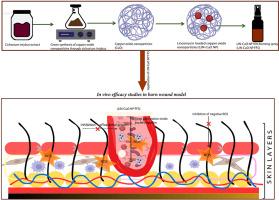生物合成林可霉素负载的氧化铜纳米粒子使用菊苣为基础的薄膜喷雾增强抗菌和伤口愈合
IF 4.9
3区 医学
Q1 PHARMACOLOGY & PHARMACY
Journal of Drug Delivery Science and Technology
Pub Date : 2025-09-25
DOI:10.1016/j.jddst.2025.107570
引用次数: 0
摘要
在临床实践中,伤口感染仍然是一个持续和重要的问题,因此需要更有效和更有针对性的治疗方案。本研究的重点是开发和评价负载林可霉素的氧化铜纳米颗粒成膜喷雾(LIN-CuO NPs-FFS),旨在加速伤口愈合。以菊苣提取物为原料,采用绿色工艺合成氧化铜纳米颗粒(CuO NPs),并利用Design Expert®软件进行优化。然后将这些优化的纳米颗粒加入成膜喷雾配方中。对LIN-CuO纳米颗粒和LIN-CuO NPs-FFS进行了全面的体外、离体、体内和稳定性分析。理化性质表征表明,纳米CuO的平均粒径为253.1±1.2 nm, zeta电位为−29.9±0.7 mV, PDI为0.2205±0.098。负载林可霉素后,其粒径增大至294±1.8 nm, zeta电位为- 30.8±0.7 mV, PDI为0.394±0.01,包封效率为87±0.2%。通过紫外光谱、XRD和FTIR分析验证了配方的结构和化学完整性。药物释放和渗透研究表明,与林可霉素成膜喷雾剂相比,它具有持久的释放模式和更好的皮肤穿透性。抗菌研究证实了有效的抗菌活性,而体内结果强调了伤口愈合,减少细菌负担和改善上皮再生。此外,该配方在六个月的储存期内保持稳定。这些发现突出了LIN-CuO NPs-FFS的治疗潜力,表明其在局部治疗mrsa感染伤口方面的有效性。本文章由计算机程序翻译,如有差异,请以英文原文为准。

Biosynthesized lincomycin loaded copper oxide nanoparticles using cichorium intybus based thin film spray for enhanced antibacterial and wound healing
Wound infections remain a persistent and significant concern in clinical practice, driving the need for more efficient and targeted therapeutic solutions. This study focuses on the development and evaluation of lincomycin-loaded copper oxide nanoparticle-based film-forming spray (LIN-CuO NPs-FFS) designed to accelerate wound healing. Copper oxide nanoparticles (CuO NPs) were synthesized via a green methodology employing Cichorium intybus extract and optimized using Design Expert® software. These optimized nanoparticles were then incorporated into a film-forming spray formulation. Comprehensive in vitro, ex vivo, in vivo, and stability analyses were conducted on both the LIN-CuO nanoparticles and LIN-CuO NPs-FFS. Physicochemical characterization indicated that the CuO nanoparticles possessed an average particle size of 253.1±1.2 nm, a zeta potential of −29.9±0.7 mV, and a PDI of 0.2205 ± 0.098. Upon lincomycin loading, the particle size increased to 294±1.8 nm, with a zeta potential of −30.8±0.7 mV, a PDI of 0.394±0.01, and an encapsulation efficiency of 87 ± 0.2 %. The formulation's structural and chemical integrity was verified through UV spectroscopy, XRD, and FTIR analyses. Drug release and permeation studies demonstrated a sustained release pattern and superior skin penetration compared to lincomycin film-forming sprays. Antimicrobial studies confirmed potent antibacterial activity, while in vivo results highlighted enhanced wound closure, reduced bacterial burden, and improved epithelial regeneration. Furthermore, the formulation remained stable over a six-month storage period. These findings highlight the therapeutic potential of LIN-CuO NPs-FFS, indicating its effectiveness for the topical management of MRSA-infected wounds.
求助全文
通过发布文献求助,成功后即可免费获取论文全文。
去求助
来源期刊
CiteScore
8.00
自引率
8.00%
发文量
879
审稿时长
94 days
期刊介绍:
The Journal of Drug Delivery Science and Technology is an international journal devoted to drug delivery and pharmaceutical technology. The journal covers all innovative aspects of all pharmaceutical dosage forms and the most advanced research on controlled release, bioavailability and drug absorption, nanomedicines, gene delivery, tissue engineering, etc. Hot topics, related to manufacturing processes and quality control, are also welcomed.

 求助内容:
求助内容: 应助结果提醒方式:
应助结果提醒方式:


